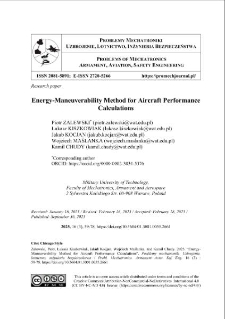Nasza Biblioteka Cyfrowa udostępnia 1 868 obiektów cyfrowych
Obiekt
Tytuł: Energy-Maneuverability Method for Aircraft Performance Calculations ; Energy-Maneuverability Method for Aircraft Performance Calculations
Tytuł odmienny:
Zastosowanie metody energetyczno-manewrowej do obliczeń osiągów statków powietrznych ; Zastosowanie metody energetyczno-manewrowej do obliczeń osiągów statków powietrznych
Współtwórca:
Łukasz KISZKOWIAK, Jakub KOCJAN, Wojciech MAŚLANKA, Kamil CHUDY ; Łukasz KISZKOWIAK, Jakub KOCJAN, Wojciech MAŚLANKA, Kamil CHUDY
Abstrakt:
During the Vietnam War, the Americans faced a problem with assessing the performance of Soviet combat aircraft. Therefore, the so-called Energy-Maneuverability (E-M) method was developed. Based on the cited method, ALR Aerospace has developed a commercial program used for preliminary calculations of aircraft performance. Recently, 5th generation aircraft such as the F-22 and the F-35 in America, the Su-57 in Russia and the J-20 in China have entered service, but little is known about their performance, just as it was the case during the Vietnam War. The author used the E-M method to calculate the so-called aircraft maneuver envelopes, allowing him to determine key aircraft performance metrics and features determining the superiority of jet fighters – e.g. maneuverability. However, the lack of relevant aircraft data (such information is not usually disclosed by manufactures) posed a significant problem. Therefore, the authors used the reverse-engineering method to determine aircraft parameters and characteristics in order to use them as input data for ALR software. Having completed their work, the authors obtained a set of aircraft characteristics and performance metrics allowing them to assess the capabilities of fighter jets and to determine the needs concerning air defense systems. The results have confirmed that the E-M method still remains effective, despite the fact that more than 70 years have passed since it was first introduced.
;
During the Vietnam War, the Americans faced a problem with assessing the performance of Soviet combat aircraft. Therefore, the so-called Energy-Maneuverability (E-M) method was developed. Based on the cited method, ALR Aerospace has developed a commercial program used for preliminary calculations of aircraft performance. Recently, 5th generation aircraft such as the F-22 and the F-35 in America, the Su-57 in Russia and the J-20 in China have entered service, but little is known about their performance, just as it was the case during the Vietnam War. The author used the E-M method to calculate the so-called aircraft maneuver envelopes, allowing him to determine key aircraft performance metrics and features determining the superiority of jet fighters – e.g. maneuverability. However, the lack of relevant aircraft data (such information is not usually disclosed by manufactures) posed a significant problem. Therefore, the authors used the reverse-engineering method to determine aircraft parameters and characteristics in order to use them as input data for ALR software. Having completed their work, the authors obtained a set of aircraft characteristics and performance metrics allowing them to assess the capabilities of fighter jets and to determine the needs concerning air defense systems. The results have confirmed that the E-M method still remains effective, despite the fact that more than 70 years have passed since it was first introduced.
Miejsce wydania:
Warszawa
;
Warszawa
Wydawca:
Wojskowa Akademia Techniczna ; Wojskowa Akademia Techniczna
Data utworzenia:
Data złożenia:
Data akceptacji:
Data wydania:
Rozmiar:
Identyfikator:
oai:ribes-88.man.poznan.pl:2742
Sygnatura:
10.5604/01.3001.0055.2661 ; 10.5604/01.3001.0055.2661
ISSN elektroniczny:
ISSN drukowany:
Język:
Licencja:
kliknij tutaj, żeby przejść ; kliknij tutaj, żeby przejść
Właściciel praw:
Wojskowa Akademia Techniczna ; Wojskowa Akademia Techniczna
Strona początkowa:
Strona końcowa:
Tom:
Czasopismo:
Słowa kluczowe:
aircraft performance, energy-maneuverability method, doghouse plot, reverse engineering ; aircraft performance, energy-maneuverability method, doghouse plot, reverse engineering
Kolekcje, do których przypisany jest obiekt:
Data ostatniej modyfikacji:
17 paź 2025
Data dodania obiektu:
17 paź 2025
Liczba wyświetleń treści obiektu:
0
Wszystkie dostępne wersje tego obiektu:
https://ribes-88.man.poznan.pl/publication/3083
Wyświetl opis w formacie RDF:
Wyświetl opis w formacie OAI-PMH:
| Nazwa wydania | Data |
|---|---|
| Energy-Maneuverability Method for Aircraft Performance Calculations | 17 paź 2025 |
Obiekty Podobne
Filipiak Dariusz Matyjaszkiewicz Magdalena A. Zalewski Piotr Postek Joanna

